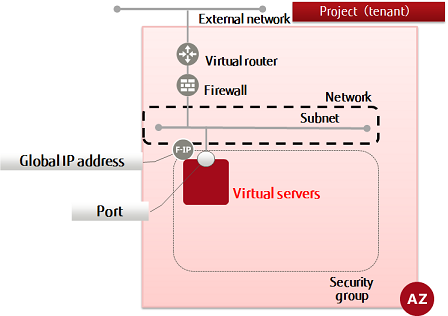This section explains how to specify a port (private IP address) and create a virtual server (Windows).
Refer to "Creating a virtual server (Windows and DHCP retrieval)" for details on retrieving a port (private IP address) using DHCP.
Follow the procedure below to create a virtual server and obtain a password. A password is required when logging in to the remote desktop.
- Set key pairs for password encryption and decryption, and create a virtual server
- Retrieve the encrypted password
- Use the key pair to decrypt and retrieve the password
DANGER
It is possible for other users to reference the passwords when using a Windows virtual server that has been deployed with admin_pass specified in the metadata, so you should change the password after deployment.
-
Set key pairs for password encryption and decryption, and create a virtual server.
Set the environment variables below as follows:
$ VM_NAME=<virtualServerName> (any)
$ IMAGE_REF_ID=<windowsimgId>
$ FLAVER_ID=<specOfVirtualServer> (listed flavor ID)
$ VOL_SIZE=80
$ DEVICE_NAME=<blockStoragePath> (specify using "/dev/vda" format)
$ SOURCE=<blockStorageType>
$ DESTINATION=<connectionDestinationVol> (specify volume)
$ ISDELETE=<volDeletion> (specify 1 to delete volumes created during creation of the virtual server, or 0 otherwise)
$ KEYNAME=<keyPairName>
$ INSTANCE_MAX=<maxNumOfServers>
$ INSTANCE_MIN=<minNumOfServers>
$ PORT_ID=<portIdToBeSpecified>
-
Execute the following API:
$ curl -Ss $COMPUTE/v2/$PROJECT_ID/servers -X POST \
-H "X-Auth-Token: $OS_AUTH_TOKEN" -H "Content-Type: application/json" \
-d '{"server": {"name": "'$VM_NAME'", "imageRef": "",
"flavorRef": "'$FLAVER_ID'", "block_device_mapping_v2":
[ {"boot_index": "0", "uuid":"'$IMAGE_REF_ID'",
"volume_size": "'$VOL_SIZE'", "source_type": "'$SOURCE'",
"destination_type": "'$DESTINATION'",
"delete_on_termination": '$ISDELETE'} ] , "max_count": '$INSTANCE_MAX',
"min_count": '$INSTANCE_MIN', "key_name":"'$KEYNAME'",
"networks": [{"port": "'$PORT_ID'"}]} }' | jq .
The following response is output:
{
"server": {
"security_groups": [
{
"name": "<specifiedSecGroupName>"
}
],
"OS-DCF:diskConfig": "MANUAL",
"id": "<newVirtualServerId>",
"links": [
{
"href": "http://10.3.0.201/v2/<projId>/servers/<newVirtualServerId>",
"rel": "self"
},
{
"href": "http://10.3.0.201/<projId>/servers/<newVirtualServerId>",
"rel": "bookmark"
}
]
}
}
-
Execute the following API to check the virtual server that you created:
$ curl -Ss $COMPUTE/v2/$PROJECT_ID/servers/detail -X GET \
-H "X-Auth-Token: $OS_AUTH_TOKEN" | \
jq '.servers[] | {status: .status, network_name: .addresses |
keys, key_name: .key_name, flavor_id: .flavor |
.id, vm_id: .id, security_group: .security_groups[] |
.name, name: .name, }'
If a list including the virtual server name that you specified is output, as follows, that means the virtual server was created successfully.
...
{
"status": "<statusOfVirtualServer>",
"network_name": [
"<connectedNetworkName>"
],
"key_name": "<keyPairName>",
"flavor_id": "<flavorId>",
"vm_id": "<virtualServerId>",
"security_group": "<specifiedSecGroupName>",
"name": "<virtualServerName>"
}
...
-
Retrieve the encrypted password.
After creating the virtual server, the interval before password retrieval can be performed is 10 minutes.
Set the environment variables below as follows:
$ SERVER_ID=<virtualServerId>
$ PROJECT_ID=<projId>
-
Execute the following API:
$ curl -s $COMPUTE/v2/$PROJECT_ID/servers/$SERVER_ID/os-server-password \
-X GET -H "X-Auth-Token: $OS_AUTH_TOKEN" | jq .
The response will be like the following:
{
"password": "~~~~ <encryptedPassword> ~~~~=="
}
-
Use the key pair to decrypt and retrieve the password.
Set the environment variable below as follows:
$ PASSWORD=<retrievedPassword>
-
Execute the following command:
$ echo $PASSWORD | openssl base64 -d -A | openssl rsautl -decrypt -inkey <pathToSpecifiedKeyFile>
